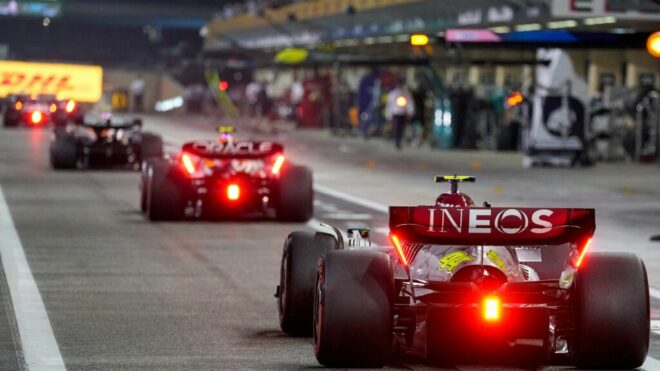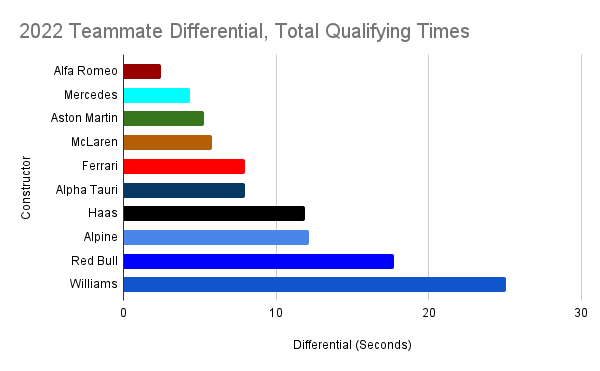-
 February 15, 2023, 12:28 pm
February 15, 2023, 12:28 pmLast Updated on February 17, 2023 1:16 pm by Steve Vidovich | Published: February 15, 2023
Toto Wolff is fond of saying “the stopwatch never lies,” and nowhere is that more true than in qualifying.
Qualifying is thought to provide the purest measure of speed in Formula 1. When you strip away the many factors that affect race outcomes, from starting position to race strategy and tire management to reliability issues, you are left with the most accurate representation of the performance of both car and driver in any given week.
This is not to say there aren’t mitigating factors in qualifying. The weather, tire choice, reliability issues, and upcoming race penalties can all impact one’s qualifying times, but there are far fewer extenuating circumstances in qualifying than in a race, and it is generally believed to be the best metric to evaluate speed in F1.
So who exactly was the fastest over the course of last year? Well, it will probably come as no surprise that 2022 World Drivers’ Champion Max Verstappen was fastest overall. When you tally up Verstappen’s fastest qualifying laps around all 22 tracks, the result is 31:13.756. This means that Verstappen drove 113.326 kilometers in just over half an hour, averaging an astounding 217.702 kph or 135.274 mph.
While Verstappen’s speed may not come as a shock, there are a number of interesting takeaways when you reorder the field by total qualifying times. The chart below is a tally of each driver’s fastest qualifying times at each of the 22 tracks on the calendar, regardless of the qualifying round in which they came. For those drivers who missed qualifying on certain weekends (Alex Albon at Imola, for example), the average qualifying time for the day was used.
Total Qualifying Times
DRIVER TOTAL Max Verstappen 31:13.756 Leader Carlos Sainz 31:15.912 +00:02.156 Charles Leclerc 31:23.853 +00:10.097 Lewis Hamilton 31:30.316 +00:16.560 Sergio Pérez 31:31.455 +00:17.699 George Russell 31:34.656 +00:20.900 Fernando Alonso 31:36.824 +00:23.068 Lando Norris 31:46.637 +00:32.881 Esteban Ocon 31:48.964 +00:35.208 Kevin Magnussen 31:50.577 +00:36.821 Daniel Ricciardo 31:52.424 +00:38.668 Valtteri Bottas 31:57.268 +00:43.512 Pierre Gasly 31:58.776 +00:45.020 Zhou Guanyu 31:59.741 +00:45.985 Mick Schumacher 32:02.436 +00:48.680 Alexander Albon 32:05.740 +00:51.984 Yuki Tsunoda 32:06.746 +00:52.990 Sebastian Vettel 32:06.821 +00:53.065 Lance Stroll 32:12.117 +00:58.361 Nicholas Latifi 32:30.773 +01:17.017 Wait, Carlos Sainz was faster than Charles Leclerc?
The first name that may jump out at you is Carlos Sainz, who finished 5th in the Drivers’ Championship, but 2nd in total qualifying times. Not only was Sainz second quickest overall, but he outperformed his teammate, Charles Leclerc, by almost 8 seconds over the course of the year. Part of the reason for the differential is due to Leclerc parking up his car after Q1 in Canada, with rain falling and engine penalties forthcoming. While Sainz went on to improve in Q2 and Q3, qualifying 3rd with a 1:22.096, Leclerc settled for a 15th place start and a 1:33.008. When you remove Canada from the equation, where there was a 10.912 second differential between the two, Leclerc was actually ahead of Sainz on the season. That will no doubt make sense to those who followed F1 in 2022, as Leclerc was consistently quick in qualifying and captured the highest number of pole positions on the year with 9.
But does that also mean Leclerc was faster than Verstappen? Leclerc certainly closes the gap to Verstappen when removing Canada, but if you’re going to eliminate qualifying times from Canada then to be fair you probably need to do so from Singapore, where Verstappen’s lack of fuel meant he never completed his final run in Q3, leaving him almost 2 seconds adrift. (For all the hubbub surrounding Monaco qualifying, Verstappen only lost out to pole sitter Sergio Perez by 0.037 seconds in Monte Carlo.) Removing both Canada and Singapore still gives Verstappen a slight edge over Leclerc. As for Sainz, the numbers show that he was a lot closer to his teammate than a 62-point differential in the Drivers’ Championship and a 15-7 qualifying head-to-head disadvantage might make it appear. Sainz was also faster than Sergio Perez and George Russell, both of whom finished ahead of him in the Drivers’ Championship.
Is Lewis Hamilton cooked?
The narrative of many people who seek to cut down Lewis Hamilton and his 7 World Drivers’ Championships is that he was outclassed in 2022 by his younger teammate, George Russell. While Russell scored 35 more points in the Drivers’ Championship and captured Mercedes’ only pole and win of the season, he was 4.340 seconds slower than Hamilton in total qualifying times. This did result on track in a 13-9 qualifying head-to-head advantage for Hamilton, but what the 13-9 number does not reveal is how well Hamilton fared against the rest of the grid. Mercedes’ total qualifying time gap to Ferrari was 25.207 seconds, but Hamilton only trailed Leclerc and Sainz by 6.463 seconds and 14.404 seconds, respectively. The Red Bulls got around all 22 tracks 19.761 seconds faster than the Mercedes, but Hamilton beat out Sergio Perez by over a second on the year. Russell had a terrific first season with Mercedes and clearly has the potential to contend for a championship in the future, but Lewis Hamilton is still quick as can be and far from over the hill.
Should Sergio Perez be looking over his shoulder?
Four teams saw double-digit differentials between their drivers: Red Bull, Alpine, Haas, and Williams. Not surprisingly, three of those four teams made a driver change. The largest teammate differential was between Alex Albon and Nicholas Latifi. Latifi was not only 25.033 seconds slower than Albon, but also 18.656 seconds behind the next slowest driver on the grid in Lance Stroll. Latifi will be replaced at Williams in 2023 by Logan Sargeant, who hopes to close the gap to Albon. The next largest differential was at Red Bull at 17.699 seconds, which could put Sergio Perez on the hot seat if Red Bull begins to attribute the deficit to Perez’s shortcomings as opposed to Verstappen’s brilliance. Some believe Daniel Ricciardo’s reunion with Red Bull is an indication that Perez’s position at the team is far from secure but if you remove Canada from the equation where Lando Norris was forced out of Q2 with a power unit issue, the differential at McLaren between Norris and Ricciardo was 16.104 seconds, the third largest on the grid. Perez probably doesn’t feel the heat from Ricciardo, but could start to feel it from elsewhere if he doesn’t close the gap to Verstappen in 2023.
The differential between Fernando Alonso and Esteban Ocon at Alpine was 12.140 seconds in Alonso’s favor, despite Ocon outscoring Alonso by 11 points in the Drivers’ Championship. Most people expect that number to increase for Alonso when pitted against new teammate Lance Stroll at Aston Martin in 2023. Stroll was slower than his 2022 teammate, Sebastian Vettel, by 5.527 seconds at the races in which they both participated in qualifying. Who comes out on top in total qualifying times at Alpine, however, will be interesting to see. Ocon outpaced his new teammate Pierre Gasly by 9.812 seconds in 2022, but Gasly was in the slower Alpha Tauri, which had a total qualifying time deficit to Alpine of 39.734 seconds. A case could be made that Gasly will be the fastest driver at Alpine this year.
The differential at Haas between Kevin Magnussen and Mick Schumacher was 11.859 seconds, something Schumacher’s replacement Nico Hulkenberg will try to improve upon in 2023. Of course, in Hulkenberg’s two qualifying appearances in 2022 as a sub for Sebastian Vettel at Aston Martin, he was only 1.016 seconds faster than his teammate Lance Stroll, who was the second slowest on the grid last year. Interestingly, the smallest differential between teammates was at Alfa Romeo, where Valtteri Bottas outpaced Zhou Guanyu by only 2.473 seconds.

How accurate a picture of the grid do total qualifying times give you?
When you step back and look at total qualifying times three major tiers emerge. The first tier is made up of Verstappen, Sainz, Leclerc, Hamilton, Perez, Russell, Alonso, and Norris, which many do consider to be the top drivers in Formula 1 today. Norris is 9.813 seconds adrift of that group but like Leclerc, not participating in Q2 or Q3 in Canada as the track dried skews Norris’ total by about 10 seconds.
The next tier consists of Ocon, Magnussen, and Ricciardo, all of whom are about 12-15 seconds slower than the first tier. The third tier is made up of Bottas, Gasly, Zhou, Schumacher, Albon, Tsunoda and Vettel. Slower than that tier by just over 5 seconds is Stroll. The one driver who is way outside of all three tiers is Latifi, 23.952 seconds behind Vettel and a whopping 1:17.017 behind Verstappen. For perspective, Verstappen would be coming around the last corner at Abu Dhabi around the same time Latifi would be starting his final qualifying lap.
What are some other interesting tidbits?
The average total qualifying time was 31:49.290, which makes Esteban Ocon the “average” driver in terms of speed in 2022.
The fastest time around any track was at the Red Bull Ring in Austria, with all 20 drivers completing the course in just 22:00.954. The average qualifying time in Austria was 1:06.436, with Verstappen topping the charts at 1:04.984.
The slowest time around any track was in Singapore, with all 20 drivers making it around the track in 37:40.261, helped in no small part by the rain. The average qualifying time in Singapore was 1:54.701, with Latifi going slowest at 1:57.532.
After the summer break, the fastest drivers in total qualifying times were Leclerc, Sainz, Verstappen, Perez, Hamilton, Norris, Alonso, and Russell. The top 5 drivers were separated by only 3.442 seconds, which bodes well for a competitive 2023.
What is the order of constructors using total qualifying times?
Ferrari tops the list with the fastest total qualifying times, edging out Red Bull by 5.446 seconds, which makes Verstappen’s already historic year look even better, for it was seemingly done while not in the fastest car on track. For those who bemoan Ferrari throwing away a legitimate chance at a championship, this number will only add fuel to their fire. Third on the road, 25.207 seconds behind Ferrari and 19.761 seconds behind Red Bull, was Mercedes, meaning the Silver Arrows have their work cut out for them to close the gap to the top this off-season. The team that is closest to the one ahead of them in total qualifying times is Alfa Romeo, who trailed Haas by only 3.996 seconds, meaning there is a real opportunity for the Sauber team to overtake the American team in 2023.
Total Qualifying Times
CONSTRUCTOR TOTAL Ferrari 1:02:39.765 Leader Red Bull 1:02:45.211 +0:00:05.446 Mercedes 1:03:04.972 +0:00:25.207 Alpine 1:03:25.788 +0:00:46.023 McLaren 1:03:39.061 +0:00:59.296 Haas 1:03:53.013 +0:01:13.248 Alfa Romeo 1:03:57.009 +0:01:11.798 Alpha Tauri 1:04:05.522 +0:01:25.757 Aston Martin 1:04:18.938 +0:01:39.173 Williams 1:04:36.513 +0:01:56.748
